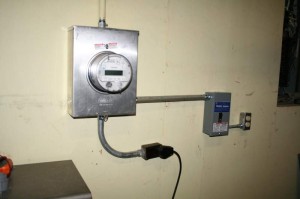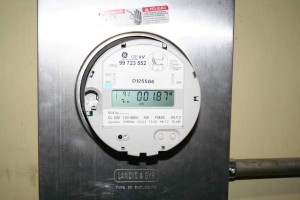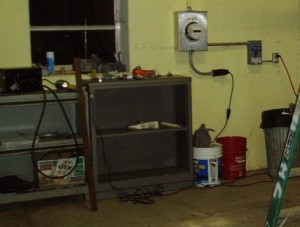Checking the efficiency of the SS Saturn EV is one of the goals I have been working on lately.
BTW ……. have over 2,000 EV miles on her.

On the left is the Quick Charger and on the right is a 110 volt outlet for the lower voltage charger
Review some things
I have 2 chargers for the pack. One is an on board 115ac volt unit that I now use only to opportunity charge while at work etc. The second, main charger is a 230ac volt unit (Quick Charge SCPX14420) that can charge with either 230 or 115 volts but I use it only on 230v, it is large and heavy. Both units are made by Quick Charge.
I installed a KWH meter and box indoors in my home shop. The main fuse box has a 50 amp circuit breaker. This 50 amp is too much to safely run a 115 volt outlet so I installed another smaller box and 20 amp breaker if I use the 115 volt outlet.
The lead below the meter box is the one going to the larger Quick Charger.
So how much energy, what is the cost to run the electric car?
There are a lot of factors, kind of batteries, weight of vehicle, terrain, motor (DC, AC etc), controller, voltage(higher is more efficient), speed, acceleration, air coefficient drag, rolling resistance, power train drag flywheel effect and driving habits.
For me there seems to be 2 ways to measure that. One is by watching the ampmeter on my dash and mentally figure OK, 150amps at 144 volts on a steady 50 mph on level ground. 150 X 144 equals 21600 watts or 22 KWH. 22KWHours will theoretically do 50 miles (50 mph) at $.12 a KWH from the power company. 22/50= .44 or 440 watts. That would leave a cost of .12 X .44 = $.05 or 5 cents a mile.
Another problem with this figure is the road is never level, I have to stop and go several times, I use up to 500 amps for a couple of seconds on take off and on decel the amp draw is ZERO.
The other way to check efficiency is with a watt meter measuring exactly what is being used off the power company grid.
Here is what I found after recording a few hundred miles of charging and writing down the figures off the meter. A 30 mile round trip driving from 40mph to 60 mph, some hills, with no charging at work. The odometer reading 176379 to 176409 took 12KWH. TVA charged 12 cents a KWH, so the charge cost me $1.44 to drive 30 miles or $.048 per mile.
EVers talk about how many watts per mile they use, in my case it is 400 watts per mile.
Actually the cost number I just gave of 12¢ a KWH is figured from my bill. I emailed the electric company and it breaks down like this. Starts at 7.261¢ per KWH then they add 1.42¢ fuel cost adjustment, $15 a month delivery fee, .7¢ higher rate if below 1,000 KWH a month and 2.0¢ higher rate if not a single-family dwelling. This is the Gibson County Tennessee General Power Rate for January through March 2009. They have no discount for night charging and no interest in electric vehicles up to this point in time. Maybe some day.
DIY Electric Car Forums wiki page is talking about this issue and battery pack size…….
The range of your conversion is determined by the efficiency (measured in Wh/mile or Wh/km) and the total energy stored in your battery pack (measured in kWh). As a general guide motor bikes will generally use 75-150Wh/mile, cars may use around 200-400 and pick-ups and heavy vehicles around 400-600Wh/mile depending on the weight, Rolling Resistance and Aerodynamics of the vehicle (also higher voltage systems are generally more efficient than lower voltage and AC systems more than DC). Since you have already determined the voltage of the pack, the range will determine the Ah rating of your battery pack so that the pack has enough energy, which is the product of voltage and amp-hours (measured in kWh), to travel the required distance. Lets say we have a round trip commute of 40 miles (65km) which we wish to travel in a standard car conversion at 120V, by looking at other conversions we estimate our own will have an efficiency of 250Wh/mile. The product of our efficiency (energy/mile) and our required range (miles) will give us total energy required for that distance. In our example, the efficiency of 250Wh/mile multiplied by the range of 40 miles gives us a total energy of 250×40=10,000W or 10kWh. Since we already determined our voltage was 120V (see step 1) this means our Ah rating will be the total energy divided by the voltage. In this case 10,000W / 120V = 83.3Ah.
The book Convert It by Michael P. Brown says … The ammeter is your ‘efficiency gauge’. By varying gears and throttle pressure while watching for the lowest current reading, you can determine the most efficient technique for accelerating, maintaining speed, or climbing a hill. Since an electric car is typically used on the same routes repeatedly, you can develop the optimum technique for each portion of your normal drive. Typical readings will be:
400 amps for momentary full acceleration
100 amps cruising on flat roads
200 amps on slight grades
300 amps on steep grades
0 when coasting
Brown does not mention vehicle weight or speed in these typical reading but they seem close to me though maybe a little low.

